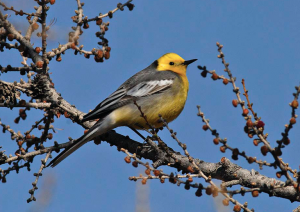Calls of Western Yellow Wagtail, Eastern Yellow Wagtail & Citrine Wagtail
Citrine Wagtail Motacilla citreola, Ikh Nart, East Gobi Province, Mongolia, 17 May 2008 (René Pop)
This page was produced to host the recordings supplied by The Sound Approach team for the BBRC paper on vagrant Yellow Wagtails, which appears in the July 2016 issue of British Birds. To find out more CLICK HERE
Text and sounds below provided by Magnus Robb & The Sound Approach:
Two main problems arise when identifying feldegg-type calls. The first is that a number of eastern wagtail taxa, including Citrine Wagtail and ‘eastern yellow wagtails’, also have harsh, modulated calls. For simplicity, lets lump these calls together as ‘citreola-type’ (although in fact Citrine and ‘eastern yellow’ are probably distinguishable based on their shape). The modulations of citreola-type calls are much finer, and the calls sound sharper and more ‘metallic’ than feldegg-type calls, much less coarse and ragged. In eastern Kazakhstan in spring, we have seen large numbers of thunbergi-lookalikes (presumably ‘plexa’), all of which had what we are calling citreola-type calls. We have also observed many hundreds of thunbergi in the Netherlands in spring, none of which had citreola-type calls. It appears that Scandinavian thunbergi don’t use citreola-type calls at all.
‘Eastern yellow wagtails’ may sometimes give unmodulated, flava-like calls. In the examples we know, the flava-like calls were given less often than modulated, Citrine-like calls. On being flushed, ‘eastern yellow wagtails’ invariably give citreola-type calls but in relaxed flight the calls can be more flava-like. Further work is required to know whether such calls can he heard throughout the range of ‘eastern’. To the best of our knowledge, pure Citrine Wagtails never give such calls.
The second problem when identifying feldegg-type calls is that in spring, flava, flavissima and thunbergi males often include modulated, descending notes in their simple songs, which could be misidentified as feldegg-type flight calls by the unwary. We have even heard such song notes from wagtails passing on active migration flights, but only in spring. We have no evidence that they may be given by autumn migrants. There are a number of ways to recognise these as song notes rather than flight calls. They are often doubled, typically longer than flight calls, and usually (though not always) given from a song-post. In sonagrams, they appear quite different from flight calls.
Note: the taxonomy used by The Sound Approach may differ from that used in the British Birds article to which this page is related.
flava-type calls only e.g. flava, flavissima, beema, thunbergi (Scandinavian at least)
Blue-headed Wagtail Motacilla flava, Texel, Noord-Holland, Netherlands, 25 April 2003 (Magnus Robb). Typical ‘flight calls from a bird perched in a bulb field, then in flight.
Grey-headed Wagtail Motacilla thunbergi, Breskens, Zeeland, Netherlands, 4 May 20016 (Magnus Robb). Flight calls of a migrating male.
Grey-headed Wagtail Motacilla thunbergi, Verdronken Zwarte Polder, Zeeland, Netherlands, 5 May 2008 (Magnus Robb). Flight calls of a migrating male.
A mixture of feldegg-type and flava-type calls e.g. cinereocapilla, feldegg (incl. melanogrisea), iberiae
Black-headed Wagtail Motacilla feldegg, Merzouga, Tafilalt, Morocco, 11 April 2005 (Arnoud B van den Berg). Typical ragged-sounding calls of a spring vagrant.
Ashy-headed Wagtail Motacilla cinereocapilla cinereocapilla, Oued Massa, Agadir, Morocco, 2 April 2002 (Arnoud B van den Berg). Typical ragged-sounding ‘flight calls’ of a perched individual.
Ashy-headed Wagtail Motacilla cinereocapilla cinereocapilla, Albufera, Mallorca, Spain, 11 April 2001 (Magnus Robb). Feldegg-type and flava-type ‘flight calls’ of a perched individual.
Ashy-headed Wagtail Motacilla cinereocapilla cinereocapilla, Camperduin, Noord-Holland, Netherlands, 16 April 2006 (Arnoud B van den Berg). Flight calls of a vagrant male.
Spanish Wagtail Motacilla cinereocapilla iberiae, Albufera, Mallorca, Spain, 30 July 2006 (Magnus Robb). Feldegg-type flight calls when taking off.
Spanish Wagtail Motacilla cinereocapilla iberiae, Albufera, Mallorca, Spain, 5 April 2003 (Magnus Robb). Flava-type flight calls of a male when flushed.
citreola-type calls only – citreola
Citrine Wagtail Motacilla citreola, Khawr Rawri, Dhofar, Oman, 17 February 2001 (Killian Mullarney). Flight calls of several.
citreola-like calls (but with slightly different shape) and occasional flava-like calls e.g. plexa, tchutschensis etc (‘eastern yellow wagtail’)
Siberian Wagtail Motacilla tchutchensis ‘plexa’, Kyzyl-Kol, South Kazakhstan, Kazakhstan, 15 May 2000 (Magnus Robb). Several loud citreola-type flight calls of a spring migrant.
Siberian Wagtail Motacilla tchutchensis ‘plexa’, Korgalzhyn Lake, Aqmola, Kazakhstan, 18 May 2003 (Magnus Robb). Calls and songs of a huge flock of spring migrants.
